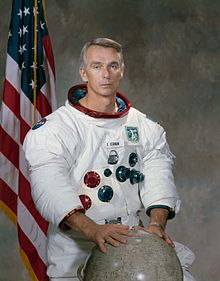Caio, logo existo.
Mário Novello, Cosmos e Contexto, 2012
The Brazilian GloboNews cable TV show Espaço Aberto – Ciência e Tecnologia exhibited, on August 08, 2011, an interview with the ex-astronaut Eugene Cernan (1934-2017), whom, amongst other missions, commanded in December 1972, the last manned mission to the Moon, the Apollo 17. He became known as the last man on the Moon, because he was the last to enter the lunar module at the end of the mission.
The interviewers were three boys and a girl and the interview lasted a little more than 20 minutes. The Apollo 17 mission was the last to bring astronauts to the surface of the Moon. The mission was 3 days long on the Moon, and occurred in December 1972, more than 40 years ago.

|
One of the interviewers, the boy Daniel Turela Rodrigues (14 years old), asked the following question: “— How was that moment that you fell on the Moon, took a tumble?”
Eugene Cernan explained that the weight of anything on the Moon is 1/6 of the weight on Earth, and that makes jumping easy on its surface. Then, the most efficient way of moving there was through little jumps, like rabbits. On the other hand, whenever he had to stop, or make a turn, it was very difficult and many times they took small tumbles.
Tumbles on the Moon highlight three important laws of Newtonian mechanics: the law of universal gravitation, the 1st and the 2nd laws of motion. The law of universal gravitation explains why the weight on the surface of the Moon is equal to one sixth of the weight on the surface of Earth. With the help of this law one can mathematically express that statement writing

where G is the universal gravitational constant, the Ms represent the masses (7.349×1022 kg and 5.9736×1024 kg) and the Rs represent the radii (1,737.4 km and 6,378.1 km) of the Moon and of the Earth, respectively. GMMoon/R2Moon is a constant and is called the gravitational acceleration on the Moon (gMoon). Likewise, GMEarth/R2Earth is a constant and is called the gravitational acceleration on Earth (gEarth ≈ 9.8 m/s2). According to the law of universal gravitation, a body of mass m has the weight mgMoon on the surface of the Moon and mgEarth on Earth, therefore, mgMoon = 1/6 mgEarth because gMoon = 1/6 gEarth.
The 1st law is the famous law of inertia, and it states that every body stays at rest or at uniform rectilinear motion unless there are forces acting upon it. To change its state of motion, the 2nd law states that it is necessary a force proportional to the desired change — that is, to the acceleration — multiplied by the mass of the body, which is a measure of its inertia. All bodies have inertia, the property to resist any change in their state of rest or motion.
Now, the weight on the Moon is 1/6 of the weight on Earth but the mass does not change! In other words, the inertia of a body does not change. And note that Eugene Cernan used an equipment of almost 100 kg! Summing everything up, he “carried” an inertia of almost 180 kg! His own mass — about 80 kg — plus the mass of his vest and equipment that, as mentioned, was of about 100 kg. When he tries to stop or make a lightly curved turn he needed the muscular strength to stop 180 kg, or to have an 180 kg mass making a lightly curved turn! Add the fact that his speed was often large and, therefore, the needed acceleration to make a sudden stop or make a fast turn would be large as well. The required force becomes also large because it is equal to mass times acceleration, as we saw.
What is the best strategy for not falling? Mass cannot be changed, therefore one must change the acceleration. Eugene Cernan and his fellow should stop slowly and make turns at low speed (remember that things get yet more complicated in a curve, because the acceleration is proportional to the square of the speed).
The astronaut also drew the attention to the high center of gravity, with respect to the ground, of the combined set of astronaut, vest and equipment. Especially in the curves, that increases considerably the instability leading to falls. And we can add: irregularities on the terrain and the low flexibility of the vest and equipment of the astronaut. All these factors, plus the implacable play between weight and mass (inertia), discussed above, were responsible by the innumerable falls on the Moon.
Let us appreciate now the lunar tumbles of Eugene Cernan and his fellow? Watch here.
Read other articles in www.fisica.ufmg.br/~dsoares/notices-e.htm.